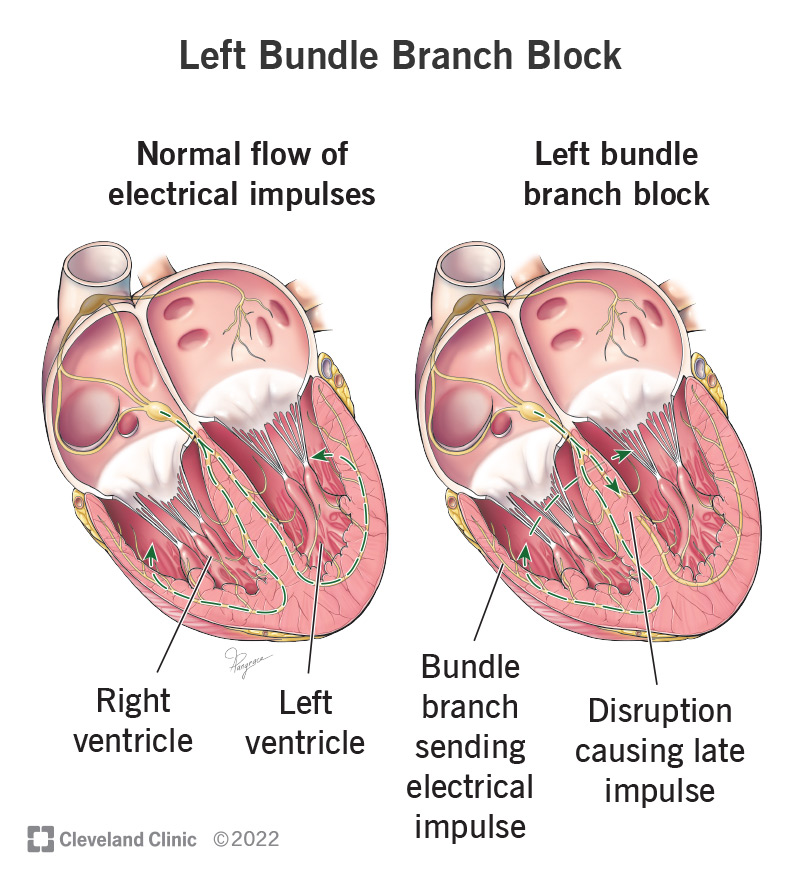Left bundle branch block results when something disrupts the electrical impulse that controls your heartbeat. It’s often not serious if you have no underlying conditions. People with heart conditions may need a pacemaker or cardiac resynchronization therapy to manage this condition. You can reduce your risk by making healthy lifestyle choices.
Advertisement
Cleveland Clinic is a non-profit academic medical center. Advertising on our site helps support our mission. We do not endorse non-Cleveland Clinic products or services. Policy

Left bundle branch block (LBBB) occurs when something blocks or disrupts the electrical impulse that causes your heart to beat. This block leads to an abnormal heart rhythm. A diagnosis of left bundle branch block often means that you have an underlying heart condition.
Advertisement
Cleveland Clinic is a non-profit academic medical center. Advertising on our site helps support our mission. We do not endorse non-Cleveland Clinic products or services. Policy
Your heart sends electrical impulses to the bottom chambers of your heart (ventricles). These impulses signal for these chambers to beat. Typically, the two bottom chambers or ventricles should beat in sync.
If you have LBBB, the bundle branch that carries the electrical impulse to your left ventricle is either partially or completely blocked. This problem causes your right ventricle to contract before your left ventricle, making it harder for your heart to pump blood efficiently.
If you have no underlying conditions, left bundle branch block may not be serious. If you have other conditions that affect your heart, LBBB may make your heart deteriorate faster and worsen your symptoms.
About 0.06% to 0.1% of the U.S. population has left bundle branch block. Left bundle branch block is more common as you age. It almost never occurs in people younger than 35. And it’s more common if you have other heart conditions. Around 33% of people with heart failure have this condition. While less than 1% of adults are diagnosed with LBBB before age 50, 6% have been diagnosed by age 80.
Left bundle branch block doesn’t go away once you have it. However, some people don’t have this condition all the time. It sometimes occurs only when your heart rate rises during exercise.
Advertisement
An incomplete left bundle branch block is a partial block of the electrical impulses. It may mean that you could develop LBBB.
Left bundle branch block often results from heart damage. Conditions that can cause LBBB include:
Sometimes, left bundle branch block has no known cause. It can occur in people whose hearts otherwise function normally and who have no underlying conditions.
Left bundle branch block may not cause any symptoms. When this condition does cause symptoms, they may include:
Healthcare providers diagnose this condition with an electrocardiogram (EKG). During an EKG, your provider attaches electrodes to the skin of your chest. You lie still while a computer records an image of electrical impulses that travel through your heart.
If your provider diagnoses you with left bundle branch block, they will check you for other health conditions related to LBBB. They may recommend the following tests:
If you don’t have symptoms or underlying conditions, you may not need treatment for left bundle branch block. You may need medication to control other issues such as high blood pressure or heart failure symptoms.
If you have symptoms such as fainting, your provider may recommend a pacemaker. Pacemakers are typically indicated when you have a conduction abnormality along with a LBBB. A surgeon implants this device under your skin in your chest. Wires connected to your heart help manage your heart’s signals so that it beats at a steady rate.
If you have heart failure, your provider may suggest cardiac resynchronization therapy (CRT). This type of pacemaker helps your ventricles contract at the same time. CRT can help reduce symptoms such as fatigue and shortness of breath.
If you’re healthy with no underlying conditions, left bundle branch block shouldn’t impact your overall health. If you’re over 65 and have heart disease or another cardiovascular disorder, untreated LBBB can be serious. This condition is associated with a higher risk of death, especially if you have heart failure or after a heart attack.
Advertisement
You may not be able to prevent left bundle branch block. But you can lower your risk of LBBB and other heart problems by keeping healthy and making smart choices. These include:
See your provider if you have any new symptoms or your symptoms worsen. Seek medical treatment immediately if you have:
To understand this condition, you may want to ask:
If you see a new doctor, always tell them if you have left bundle branch block. This information will help them better monitor your heart health and overall wellness.
If you or a loved one has left bundle branch block, talk to your healthcare provider about the best ways to improve your quality of life. If you aren’t experiencing symptoms, you may not need treatment. If you do have symptoms, talk to your provider about whether a pacemaker or cardiac resynchronization therapy can help you. See your health provider immediately if you experience any new symptoms.
Advertisement
When your heart rhythm is out of sync, the experts at Cleveland Clinic can find out why. We offer personalized care for all types of arrhythmias.

Last reviewed on 06/14/2022.
Learn more about the Health Library and our editorial process.